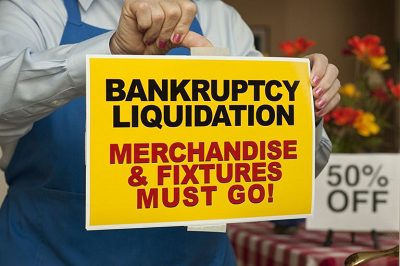It’s become a depressingly familiar headline in 2017: [RETAILER NAME HERE] Declares Bankruptcy, Closes [XX] Stores. The Payless Chapter 11 filing on April 4 makes it the 10th retailer to declare bankruptcy in 2017. That’s more than all retail bankruptcies in 2016, according to CNBC. The rash of retail peril in Q1 puts the industry on pace to match, or even exceed, the 18 retailers that went bust during the Great Recession year of 2009.
Other retailers recently declaring bankruptcy include: Limited Stores, American Apparel, bcbg Max Azria, hhgregg, Gordmans, Gander Mountain and Wet Seal. Additionally, Sears Holdings executives have admitted the depth of the company’s financial problems, and many analysts are already preparing the venerable retailer’s obituary.
So is it time to man the lifeboats on the good ship S.S. Retail? Not according to nine leading industry experts who have shared exclusive insights with Retail TouchPoints. While they acknowledge the challenges facing both individual retailers and the industry as a whole, most agree that this “bankruptcy bug” is not necessarily indicative of fundamental problems.
Advertisement
“The slew of bankruptcies this year does not necessarily indicate a weak retail sector,” said Madeline Hurley, IBISWorld Industry Analyst. “In fact, retail sector sales increased 2.6% in 2016 and 5.6% so far this year. The retail companies closing stores and going bankrupt have largely failed to adapt to the shift towards e-Commerce and away from malls.”
Several industry experts note that many of the companies declaring bankruptcy are concentrated in a few highly competitive verticals. “The majority of weakness that we have seen is in apparel, footwear and related segments, consistent with our expectation that these segments are overstored, overstocked, and simply out of alignment with consumer share of wallet/spend,” said Leslie Hand, Vice President of IDC Retail Insights. “While some sales are moving into e-Commerce, that isn’t the primary challenge retailers are facing. The consumer journey is not what it used to be, and the retailers that fail to digitally transform business to serve the customer everywhere in their ‘stream of life’ will miss the mark.”
“Most bankruptcies are fashion and specialty retailers that are not reacting to changing trends,” noted Walter Deacon, principal at BRP Consulting.
Other analysts, however, believe an industrywide correction is taking place. “I think we are just in the middle of a time period where the market is equalizing itself,” said Jerry Sheldon, VP of Technology, IHL Services. “There is currently overcapacity of brick-and-mortar stores, and we’re going to continue to see the market reach equilibrium over the next several years. When you look at overall retail revenue growth, numbers are actually healthy (adding in online sales), and there are retailers such as dollar stores that are continuing to expand.”
There also are fundamental market changes that are making things tougher for established retail players. “I do not believe [the bankruptcies] reflect a weakness in consumer spend,” said Thomas McElroy, Principal, Retail and Distribution, Deloitte Consulting. “We are seeing a couple of key dynamic market changes that are reshaping retail. One is the shift from product to experiences. We are also finding that the market is fragmenting — new market entrants are taking tiny slivers of share away from the retail powerhouses. New, emerging players have been collectively stealing share from large, traditional retailers to the tune of $200 billion in annual sales over five years (2010 to 2015). These fundamental changes are making it more difficult for traditional retail institutions to thrive and grow in the ways they have in the past.”
Real Estate Becomes A Real Burden
A major issue plaguing many retailers is how to make more effective use of their brick-and-mortar stores. “Consumers expect stores to help them learn about new products and new brands; they don’t need to rely on a local store’s inventory to find what they need when they can have most things delivered to their doorsteps in a day, sometimes sooner,” said Zach Ware, Partner, VTF Capital.
For some retailers, their physical footprint has become an Achilles heel. “The retailers who are having a tough time this year are the ones that generally used stores as local warehouses,” Ware added. “We expect the trend of bankruptcies to continue mostly to help these retailers clear their balance sheets of retail space obligations. The bankruptcies of companies like Limited Stores demonstrates that mass brands no longer have a competitive advantage simply by being large. Many mass retailers are too bloated with fixed overhead to easily change course with changing consumer values.”
For those retailers that can adapt, brick-and-mortar remains profitable. “Malls are not dead — look at the Apple Stores that are always busy and have extremely high sales per square foot,” said Ken Morris, Principal at BRP Consulting. “With the right product and shopping theater, retail stores can be successful. Retailers also need to look a sales in a different way. With webrooming, showrooming and catalog-rooming, we shouldn’t try to attribute sales to a specific touch point like the ‘last-touch’ model, as the consumer’s decision process is often impacted by many brand interactions — not just the last one.”
How Many More Retailers Will Go Under In 2017?
The importance of holiday sales to the bottom line tend to make bankruptcies (and executive changes) pile up at the beginning of the calendar year. If a retailer was counting on a strong holiday to rescue the company’s finances, but the actual results are disappointing, drastic measures become necessary.
“Retailers tend to announce store closing, bankruptcies, and challenges after year end, so I do not expect to see an additional rash of announcements — although we may see clarifications, adjustments and next steps at mid-year,” said IDC’s Hand.
Others, however, see the potential for a continuous wave of Chapter 11 filings. “Indications are that the pace will continue,” said Greg Portell, Lead Partner in the retail practice of A.T. Kearney. “Struggling retailers have boxed themselves in, leaving few levers to pull prior to financial restructuring. Management teams are paying the price for choosing incremental changes in the face of trends that everyone knew wouldn’t abate. We need to stop referring to this set of circumstances as a disruption and acknowledge this is the new retail world. It is one that is faster, higher-touch and better curated each day. Those types of changes are hard to implement quickly, which leads to the cascade of bankruptcies.”
“We’ll continue to hear the news of retailers downsizing or falling into administration/bankruptcy protection,” said IHL’s Sheldon. “For those that follow retail internationally, not only is this occurring in North America, but also in Western Europe. And while certainly Amazon’s influence is a causative factor, it is not the only one. Consumers, especially younger consumers are more apt to spend on experience instead of ‘stuff.’ Smart retailers will adjust, and those that don’t will likely be put into peril.”
Which Retailers Are Most At Risk?
Most industry experts agree that there’s less and less room for “me-too” offerings. “Any retailer that is selling a commodity product is at risk for bankruptcy,” said Brian Brunk, Principal at BRP Consulting. “Retailers that are vertically integrated manufacturers with private label products that can’t be purchased anywhere else are better positioned for success.”
IBISWorld’s Hurley identified key characteristics of at-risk companies: “Retailers with high store counts, that stock products that are subject to competition from online retailers and off-price stores,” she said, adding that “national level clothing retailers, department stores, sporting goods stores and electronics stores are at particular risk due to the numerous alternative shopping channels available for consumers.”
One thing almost everyone agrees on are the dim prospects for Sears Holdings. “To me it is highly unlikely that either Sears or Kmart will be around by the end of next year,” said Sheldon. “Currently many of Sears/Kmart’s suppliers have been reported to be tightening payment terms to 15 days. Some vendors will no longer ship to them. Given the Christmas buying season is rapidly approaching, it would seem to put them in a particularly difficult situation with regards to their cash on hand and available credit. They’ve really been dead man walking for some time, and given the abysmal performance over the last six-plus years, and the lack of a coherent rescue/turnaround plan at the very highest level in the organization, I would be hard pressed to imagine how they could be salvaged at this point.”









